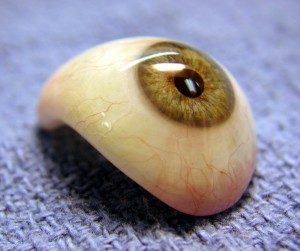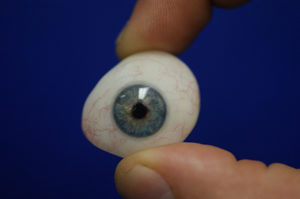The people who will make your artificial eye are known as "Ocularists" (pronounced: "Ock-You-Lair-Ists") and are engaged in the practice of "Ocularisty". There is an Ocularist Society of India, and research of new techniques and product development, stressing the benefits of custom-made ocular prosthetics and product development, is published in the Society's annual Journal of Ophthalmic Prosthetics.
Ready-made or Impression Fit Custom Eyes?
Significant differences exist between custom-made and stock ready-made artificial eyes.
- Custom-made artificial eyes (ocular prostheses) are recommended by Ocular Plastic Surgeons and Ocularist because the individual characteristics and physical requirements of the wearer are taken into consideration.
- Custom-made artificial eyes generally provide greater comfort, better eye movement and a superior natural looking result.
- A stock artificial eye, as the name implies, is ready-made and are fit by a trial and error method. Most of these glass or plastic stock eyes are mass-produced in a variety of standard sizes, shapes and iris colors.
- The fitter of stock artificial eyes must try several different shapes and sizes into the socket in an effort to find one that appears to fit and look like the companion eye.
- However, common sense would dictate, that without taking an impression of the socket, there is no assurance that the prefabricated shape selected is the proper shape for the individual socket.
- Stock artificial eyes when offered, are often not any less expensive than custom eyes, but are usually far less satisfactory in terms of fit, comfort and personal iris color matching.



Custom made ocular prosthesis
- Any patient who has an anophthalmic socket may benefit from custom made prosthesis this may be post-surgical, after enucleation, evisceration, or orbital exenteration.
- The surgery may have been performed for a condition of intra-ocular tumor, infection, or trauma: none of these conditions is a contraindication for fitting of a custom prosthesis.
- A disfigured blind eye with volume loss such as with phthisis bulbi can receive a custom-prosthesis.
- A painful blind eye or an anterior staphyloma can receive prosthesis after preliminary surgery.
- Congenital anomalies such as severe microphthalmos or anophthalmos can also be fitted with a custom prosthesis.
- A patient who has been previously using stock eyes, experiencing irritation, pain or discharge would also benefit from superior cosmesis, motility and wearer comfort of the custom prosthesis.
- Patients on stock eyes who show enophthalmic appearance, squint, or defective closure of the lids will have improved appearance with a custom made eye.
- Pre-Fitting Assessment.
